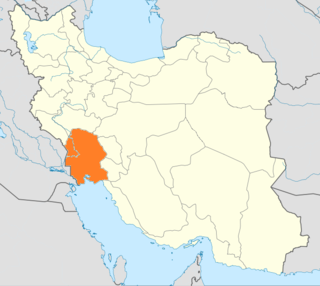
The Persian Gulf, sometimes called the Arabian Gulf, is a mediterranean sea in Western Asia. The body of water is an extension of the Indian Ocean located between Iran and the Arabian Peninsula. It is connected to the Gulf of Oman in the east by the Strait of Hormuz. The Shatt al-Arab river delta forms the northwest shoreline.

The United Arab Emirates is a country in the eastern part of the Arabian Peninsula located on the southeastern coast of the Persian Gulf and the northwestern coast of the Gulf of Oman. The UAE consists of seven emirates and was founded on 2 December 1971 as a federation. Six of the seven emirates combined on that date. The seventh, Ras al Khaimah, joined the federation on 10 February 1972. The seven sheikdoms were formerly known as the Trucial States, in reference to the treaty relations established with the British in the 19th century.

The Shatt al-Arab, sometimes called the Arvand Rud, is a river of some 200 kilometres (120 mi) in length that is formed at the confluence of the Euphrates and Tigris rivers in the town of al-Qurnah in the Basra Governorate of southern Iraq. The southern end of the river constitutes the Iran–Iraq border down to its mouth, where it discharges into the Persian Gulf. The Shatt al-Arab varies in width from about 232 metres (761 ft) at Basra to 800 metres (2,600 ft) at its mouth. It is thought that the waterway formed relatively recently in geological time, with the Tigris and Euphrates originally emptying into the Persian Gulf via a channel further to the west. Kuwait's Bubiyan Island is part of the Shatt al-Arab delta.

Khuzestan Province is one of the 31 provinces of Iran. It is in the southwest of the country, bordering Iraq and the Persian Gulf. Its capital is Ahvaz and it covers an area of 63,238 square kilometres (24,416 sq mi). Since 2014, it has been part of Iran's Region 4.

Khorramshahr is a city and capital of Khorramshahr County, Khuzestan Province, Iran. At the 2016 census, its population was 170,976, in 47,380 households.

Ahvaz is a city in the southwest of Iran and the capital of Khuzestan province. Ahvaz's population is about 1,300,000 and its built-up area with the nearby town of Sheybani is home to 1,136,989 inhabitants. It is home to Persians, Arabs, Bakhtiaris, Dezfulis, Shushtaris, and others. Languages spoken in the area include Persian and Arabic, as well as dialects of Luri (Bakhtiari), Dezfuli, Shushtari, and others.

Khazʽal bin Jabir bin Merdaw al-Kaʽbi, Muaz us-Sultana, and Sardar-e-Aqdas, was the Ruler of Arabistan, the Sheikh of Mohammerah from the Kasebite clan of the Banu Ka'b, of which he was the Sheikh of Sheikhs, the Overlord of the Mehaisan tribal confederation and the Ruler of the Shatt al-Arab.

The history of Khuzestan Province, a province in southwestern Iran, extends from the ancient pre-Aryan Elamite civilization to the modern day Islamic Republic.
Jabir Bin Merdaw Al-Kaabi was the Sheikh of Mohammerah during the 19th century.

The Iran–Iraq border runs for 1,599 km from the tripoint with Turkey in the north down to the Shatt al-Arab waterway and out to the Persian Gulf in the south. Although the boundary was first determined in 1639, certain disputes continue, particularly surrounding navigation on the Shatt al-Arab.
The Banu Ka'b are an Arab nomadic tribe originating in the Najd region of Arabia, who often raided, then settled various areas of southern and central Ottoman Iraq, in cities such as Basra and Nasariyah, and also across the border in the southernmost region of Khuzestan Province of Persia, particularly near the city of Khorramshahr. From the early 18th century onwards, the Banu Ka'b began converting from Sunni to Shia Islam.

Iran–Iraq relations are the diplomatic and foreign relations between the two sovereign states of Iran and Iraq.

The Trucial States, also known as the Trucial Coast, the Trucial Sheikhdoms, Trucial Arabia, and Trucial Oman was the name the British government gave to a group of tribal confederations in southeastern Arabia whose leaders had signed protective treaties, or truces, with the United Kingdom between 1820 and 1892.
1921 Persian coup d'état, known in Iran as 3 Esfand 1299 coup d'état, refers to several major events in Persia in 1921, which eventually led to the establishment of the Pahlavi dynasty as the ruling house of the country in 1925.

Arab separatism in Khuzestan refers to the century-long separatist Arab movement in the western part of the Khuzestan Province in Iran.

Sheikh Khazal rebellion refers to the 1924 Arab separatist uprising by Khazal al-Kabi, the Sheikh of Mohammerah, in Iranian Khuzestan. The rebellion was quickly and efficiently suppressed by Reza Shah with minimal casualties, subduing the Bakhtiari tribes allied with Sheikh Khazal and resulting in his surrender.

Sheikh Abdullah Bin Khaz'al was the son of Sheikh Khazʽal Ibn Jabir of the Emirate of Mohammerah, overlord of the Muhaisin tribal confederation and Emir of the oil rich emirate of Mohammerah, today part of the Iranian province of Khuzistan. He led the 1945 movement "The revolt of Sheikh Abdullah Bin Khaz'al" against the Iranian government, but failed.
The Shatt al-Arab dispute was a territorial dispute that took place in the Shatt al-Arab region from 1936 until 1975. The Shatt al-Arab was considered an important channel for the oil exports of both Iran and Iraq, and in 1937, Iran and the newly independent Iraq signed a treaty to settle the dispute. In the 1975 Algiers Agreement, Iraq made territorial concessions—including the Shatt al-Arab waterway—in exchange for normalized relations. In return for Iraq agreeing that the frontier on the waterway ran along the entire thalweg, Iran ended its support for the Peshmerga in the Second Iraqi–Kurdish War. The Iraqi government reneged on the Agreement shortly before launching the Iran-Iraq War in 1980, but accepted it once more in 1988 after the war.

The province of Khuzestan was a south-western province of Safavid Iran, corresponding to the present-day province of Khuzestan.














